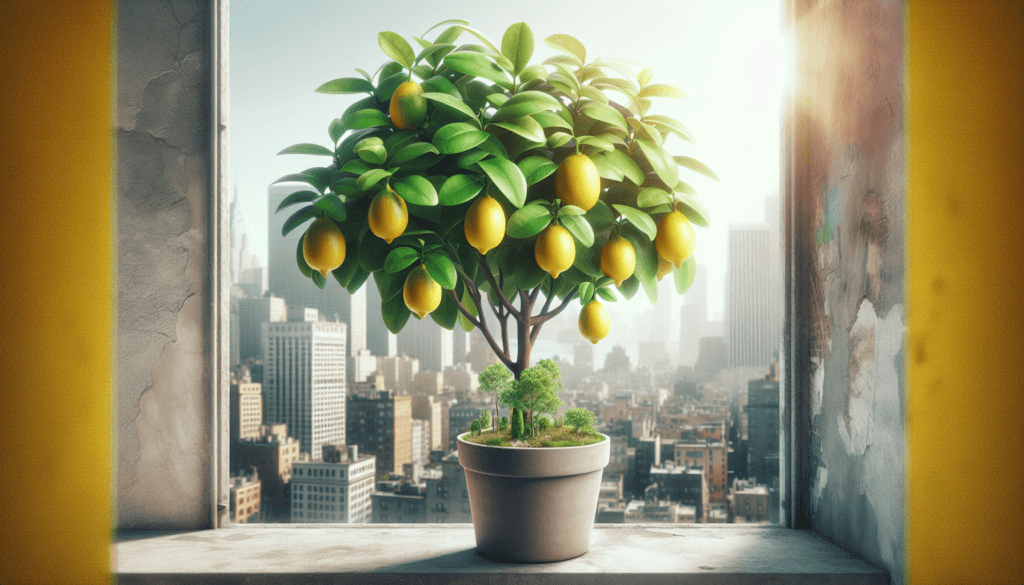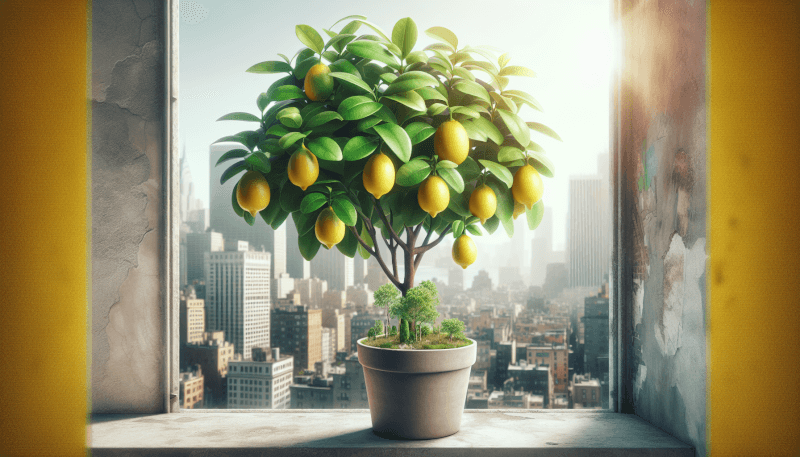Are you a plant lover itching to bring a touch of nature into your urban living space? Look no further than growing indoor fruit trees! With these urban gardening tips, you’ll learn how to cultivate your very own mini orchard right in your own home. From selecting the perfect variety to providing the optimal growing conditions, this article will guide you through the steps to ensure a bountiful harvest of fresh and delicious fruit. Get ready to experience the joy of urban gardening and savor the taste of homegrown fruit!
Choosing the Right Fruit Trees
When it comes to choosing fruit trees for indoor gardening, the first thing you need to consider is the size of your space. Different fruit trees have different space requirements, so it’s important to choose a variety that will fit comfortably in your home. If you have limited space, opt for dwarf or miniature fruit trees that are specially bred to grow in small containers.
Another crucial factor to consider is the climate and lighting requirements of the fruit tree. Some fruit trees thrive in humid conditions, while others prefer dry climates. Additionally, fruit trees need plenty of sunlight to produce delicious fruits, so make sure that your chosen variety can adapt to the available light in your home.
Lastly, you need to decide on the type of fruit tree you want to grow. Are you dreaming of juicy oranges, tangy lemons, or sweet strawberries? Consider your personal preferences and the feasibility of growing a certain fruit tree indoors. Some trees, like citrus trees, are better suited for indoor gardening due to their adaptability to container cultivation.
Preparing the Pot and Soil
After choosing the right fruit tree for your indoor garden, it’s time to prepare the pot and soil. Select a suitable pot that is large enough to accommodate the root system of the tree, allowing it to grow comfortably. Ensure that the pot has drainage holes to prevent waterlogging, as excessive moisture can lead to root rot.
Using high-quality potting mix is essential for the healthy growth of your fruit tree. This type of soil is designed to provide adequate nutrients and proper drainage, promoting root development and overall plant health. Avoid using regular garden soil, as it may contain pests or diseases that could harm your tree.
Proper drainage is crucial to prevent water from accumulating at the bottom of the pot and suffocating the roots. If your chosen pot doesn’t have drainage holes, you can add a layer of stones or broken pottery at the bottom to create a drainage system. This will allow excess water to escape and help maintain the optimal moisture level for your fruit tree.

Planting the Fruit Tree
Before planting the fruit tree, it’s important to soak the seeds or prepare a sapling for germination. Soaking the seeds in water overnight can help loosen their outer coating and promote better germination rates. For saplings, gently remove them from their nursery container and loosen the roots before planting.
Once your seeds or sapling are ready, plant them in the prepared pot with the potting mix. Make sure the roots are well-covered with soil and gently firm it around the base of the tree. Water the plant thoroughly after planting to ensure that the soil settles around the roots and provides the necessary moisture.
Providing Adequate Lighting
Proper lighting is crucial for the successful growth of indoor fruit trees. Position your fruit tree near a sunny window that receives at least 6-8 hours of sunlight per day. South-facing windows usually provide the most light, but east or west-facing windows can also work depending on your location and the intensity of the sunlight.
If your home doesn’t have access to sufficient natural light, consider using supplementary lighting options. LED grow lights are an excellent choice as they provide the specific spectrum of light that plants need for photosynthesis. Place the lights close enough to the fruit tree so that it receives the equivalent of 6-8 hours of sunlight each day.
Consistency in light exposure is paramount for fruit tree health. Avoid moving the tree around too frequently as it can disrupt its growth and overall development. Once you find the optimal spot, try to maintain a consistent light exposure schedule for your fruit tree.

Maintaining Optimal Temperature and Humidity
Temperature and humidity are two important factors to consider when growing indoor fruit trees. Most fruit trees prefer a temperature range between 60-75°F (15-24°C), so it’s important to keep your home within this suitable range. Avoid placing the tree near cold drafts, such as windows or doors, as sudden temperature fluctuations can harm its growth.
Humidity levels also play a crucial role in the health and vitality of indoor fruit trees. Most fruit trees prefer a moderate to high humidity environment, around 50-70%. To maintain adequate moisture, you can use a humidifier or place a tray of water near the tree. Additionally, misting the leaves of the fruit tree regularly can help increase humidity levels.
Watering and Fertilizing
Proper watering is crucial for the successful growth of indoor fruit trees. Water your fruit tree regularly and consistently to keep the soil moist but not overly saturated. The frequency of watering will depend on factors such as the size of the pot, the type of fruit tree, and the environmental conditions in your home. Check the soil regularly by sticking your finger about an inch into the soil to check for moisture before watering.
Pay attention to signs of overwatering or underwatering. If the leaves start to turn yellow or wilt, it may indicate that you are either watering too much or too little. Adjust your watering schedule accordingly to maintain the optimal moisture level for your fruit tree.
Fertilizing your indoor fruit tree is important to provide it with the necessary nutrients for healthy growth. Use a balanced, slow-release fertilizer specifically formulated for fruit trees. Follow the instructions on the packaging for the correct dosage and frequency of application. Overfertilizing can lead to fertilizer burn, so be cautious and apply the fertilizer sparingly.

Pruning and Training
Pruning is an essential step in managing the size and shape of your indoor fruit tree. Regular pruning helps maintain the tree’s overall health, promotes proper airflow, and ensures the development of strong branches. Remove any dead or diseased branches promptly to prevent the spread of diseases.
Training the branches of your fruit tree is important for proper structure and fruiting. Use soft ties or plant clips to guide the branches in the desired direction. This will help prevent overcrowding and ensure that the fruit receives adequate sunlight for optimal ripening.
Dealing with Pests and Diseases
Preventing pests and diseases is an important aspect of indoor fruit tree care. Implementing preventive measures such as regularly inspecting the tree for signs of pests, applying organic pest control methods, and maintaining good hygiene around the tree can help prevent infestations.
Identify common pests and diseases that may affect your fruit tree. Spider mites, aphids, and scale insects are common pests that can harm indoor fruit trees. Fungal diseases like powdery mildew and root rot can also pose a threat. Research the specific signs and symptoms of pests and diseases that are known to affect your chosen fruit tree and take appropriate action if you observe any issues.
When dealing with pests, opt for organic methods of control to minimize the use of harmful chemicals. This can include using insecticidal soaps, neem oil, or introducing beneficial insects that prey on pests. Regularly cleaning the leaves and inspecting the plant can also help prevent pest infestations.

Pollination and Fruit Set
Understanding the pollination requirements of your indoor fruit tree is crucial for achieving successful fruit production. Some fruit trees are self-pollinating and don’t require additional assistance, while others benefit from cross-pollination with another compatible variety.
If your fruit tree requires cross-pollination, you can assist in the process by gently brushing the flowers with a soft paintbrush to transfer the pollen. This mimics the action of bees in natural pollination. Alternatively, you can introduce a compatible pollinator plant nearby to ensure adequate cross-pollination.
Promote fruit set by providing proper care to your indoor fruit tree. Maintain optimal temperature and humidity levels, ensure consistent light exposure, and provide regular watering and fertilizing. These factors contribute to the overall health of the tree and increase the chances of successful fruit development.
Harvesting and Enjoying the Fruits
The moment you’ve been waiting for has arrived – it’s time to harvest and enjoy the fruits of your labor! Observe the signs of fruit readiness, such as a change in color, size, or texture. Fruits should be plump, aromatic, and easily detach from the tree when gently pulled.
Harvest the fruits gently to avoid damage. Use a pair of clean pruning shears or scissors to cut the fruit from the tree, leaving a small stem attached. This will help prolong the shelf life of the fruit and prevent any damage to the tree.
Store your freshly harvested fruits at their peak ripeness. Some fruits, like apples and pears, can be stored in a cool, dark place for several weeks. Others, like berries and citrus fruits, are best enjoyed immediately. Make sure to wash the fruits before consuming them and savor the delicious flavors of your indoor garden-grown fruits.
In conclusion, growing indoor fruit trees can be a rewarding and fruitful experience. By choosing the right fruit tree, preparing the pot and soil, providing adequate lighting, maintaining optimal temperature and humidity, watering and fertilizing appropriately, pruning and training, dealing with pests and diseases, ensuring proper pollination, and harvesting and enjoying the fruits, you can create a thriving indoor garden full of delicious fruits to enjoy year-round. Happy gardening!


